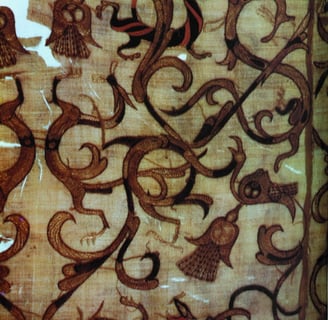Shang and Zhou Silk: The Fusion of Technology, Culture, and Archaeological Evidence
QIPAO FABRIC
5/24/20253 min read


Origins and Technology: Evolution from the Neolithic to Shang and Zhou
Tracing the Origins
The embryonic form of silk can be traced back to the Neolithic Age 5,000 years ago. Early silk relics have been discovered in both the Yangtze River Basin (e.g., the Qianshanyang Site in Zhejiang) and the Yellow River Basin (e.g., the Qingtai Site in Xingyang, Henan). During the Shang and Zhou dynasties, sericulture and silk reeling technology matured, forming a complete industrial chain.
Core Technological Breakthroughs
Silk Reeling Techniques:
The Shang Dynasty popularized the hot-water reeling method, controlling water temperature through three soakings to separate sericin from fibroin. In the Western Zhou period, the "floating boiling method" emerged, requiring repeated pressing of the cocoon shell to extract silk threads.
Weaving Tools:
H-shaped and I-shaped silk racks were used for winding silk, with the embryonic form of a hand-cranked spinning wheel appearing in the Spring and Autumn period. The crinkled silk fabric unearthed from the Taixicun Site in Gaocheng, Hebei, demonstrates complex techniques such as silk plying and twisting.
Jacquard Technology:
The Shang and Zhou dynasties could weave jacquard fabrics like luo (gauze), qi (damask), and jin (brocade). For example, the painted embroidered silk from Western Zhou tombs required multi-heddle jacquard looms to create.
Dyeing and Patterns:
Mineral pigments (e.g., cinnabar, realgar) and plant dyes (e.g., indigo, madder) were used concurrently, expanding the color spectrum. Silk patterns mainly featured fret patterns and thunder patterns, reflecting a simple and ancient aesthetic.
Social Status and Cultural Symbols
Exclusive Privilege of the Nobility and Ritual Functions
Silk was a symbol of noble identity in the Shang and Zhou dynasties, used to make ceremonial robes, , and sacrificial garments . Silk impressions unearthed from Western Zhou tombs often lie beside noble skeletons, highlighting their exalted status.
Economic Pillar and Industrial Division of Labor
Silk production promoted specialized division of labor in agriculture (mulberry cultivation) and handicrafts (textile weaving), forming a complete system of "mulberry planting, silkworm rearing, silk reeling, weaving, and dyeing," driving ancient economic prosperity.
A Medium for Cultural Exchange
Through the "Silk Road," Shang and Zhou silk technologies spread westward to Central Asia, facilitating East-West technological exchange. Exotic elements in silk patterns (e.g., West Asian motifs) reflect early cross-cultural interactions.
Archaeological Evidence: From Artifacts to Technological Reconstruction
Key Archaeological Discoveries
Western Zhou Tomb at Rujiazhuang, Baoji:
Unearthed red and realgar-yellow silk impressions confirm the maturity of painting and embroidery techniques in the Western Zhou period.
Rock Tombs at Guixi, Jiangxi:
The discovery of an H-shaped silk-winding rack from the Spring and Autumn and Warring States periods provides physical evidence for studying silk reeling tools.
Taixicun Site, Gaocheng, Hebei:
The crinkled silk fabric found here has a warp twist of 2,500–3,000 twists per meter, showcasing superb silk-plying craftsmanship.
Technological Reconstruction and Influence
Archaeological findings of silk-weaving tools and artifacts 印证 (confirm) the silk-reeling processes recorded in documents like The Book of Rites: On Sacrifices, advancing research into reconstructing Shang and Zhou textile technologies.
The spread of silk production techniques accelerated the development of the textile industry in Central and West Asia, forming cross-regional technological exchange networks.
Historical Legacy and Modern Insights
Shang and Zhou silk represents not only the technological pinnacle of ancient China but also a vital symbol of Chinese civilization. The integrity of its industrial chain and technological innovation laid the foundation for the prosperity of later silk industries. From archaeological evidence to cultural exchange, Shang and Zhou silk reveals the early interaction model between China and the world, offering profound insights into understanding the integration of ancient economies, technologies, and cultures.
When archaeologists gently brushed away the dust on the bronze ware, a fragment of silk print awakened in the dark tomb chamber - this is not an ordinary fabric, but a civilization code woven by the ancestors of the Shang and Zhou dynasties with silk. From the mulberry forests in the Yellow River Basin to the silkworm houses in the Yangtze River Basin, from clumsy silk reeling tools to exquisite jacquard looms, silk completed the transformation from a practical item to a cultural symbol during the Shang and Zhou dynasties. It is not only the splendor of aristocratic dresses, but also a medium for worshiping heaven and earth, and also a link between the Central Plains and the border, and between China and the world. Today, let us unravel the technical and civilization codes behind the silk of the Shang and Zhou dynasties through the oracle bone inscriptions, the patterns of bronze ware and the fragments in the ancient tombs.


